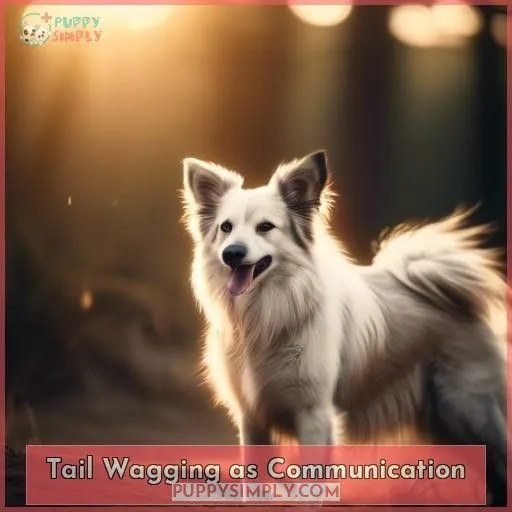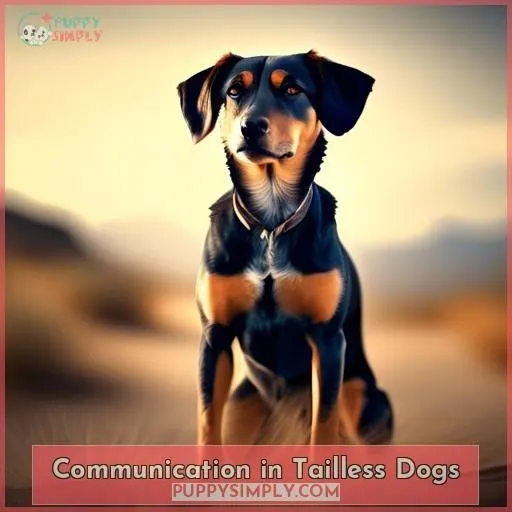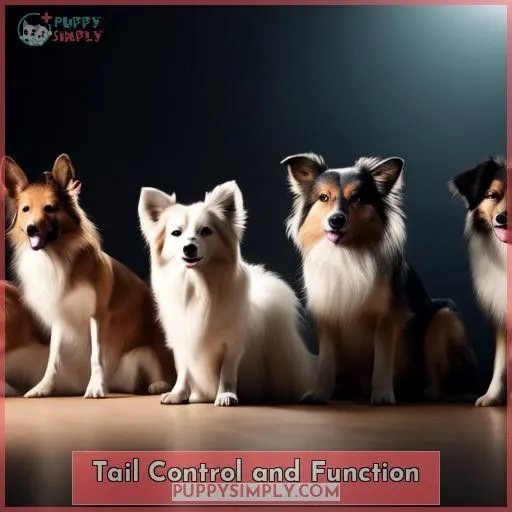This site is supported by our readers. We may earn a commission, at no cost to you, if you purchase through links.
As a dog owner, you may have observed that canines with curly tails display a distinctive manner of communication. These curly-tailed pups employ their exceptional tail formation to convey an array of feelings and objectives. The configuration, posture, and adaptability of their tails enable them to express readiness, hostility, subservience, and more with remarkable subtlety.
Whether it’s the spiral curls of a Basenji or the crescent-shaped wags of other breeds, these mesmerizing tails provide an enchanting insight into the inner thoughts of our canine companions. Exploring the depths of curly-tailed dog communication can unveil an entirely new appreciation for man’s most loyal ally.
Table Of Contents
- Key Takeaways
- Tail Wagging as Communication
- Why Dogs Wag Their Tails
- Messages Conveyed by Tail Wags
- Wagging Speed and Direction
- Communication in Tailless Dogs
- Dog Tail Variety
- Types of Curly Dog Tails
- Tail Control and Function
- Basenji: a Unique Curly-Tailed Dog
- Frequently Asked Questions (FAQs)
- How does the tail wagging behavior of curly-tailed dogs differ from that of non-curly-tailed dogs?
- What are the different types of curly tails found in dogs and how do they affect the dogs behavior and communication?
- How does the shape and structure of a dogs tail affect its ability to communicate?
- What are the health considerations for dogs with curly tails, especially those with corkscrew tails?
- How do curly-tailed dogs adapt to different environments and what are the challenges they face?
- Conclusion
Key Takeaways
- Curly-tailed dogs use their unique tail formations to communicate a wide range of emotions and intentions, including readiness, hostility, and submissiveness, with remarkable subtlety.
- The speed, direction, and style of tail wagging in dogs, including those with curly tails, provide valuable insights into their emotional state, with different wagging patterns indicating happiness, excitement, insecurity, aggression, and submission.
- Dogs with curly tails, such as the Basenji, have specific physical characteristics and tail shapes, like corkscrew and sickle-shaped tails, that influence their communication abilities and reflect their emotional and physical states.
- Health considerations for dogs with curly tails, especially those with corkscrew tails, include potential spinal deformities and nerve impairment, highlighting the importance of regular veterinary check-ups to ensure their well-being.
Tail Wagging as Communication
Tail wagging is a crucial form of communication for dogs, serving as a visual language that conveys a wide range of emotions and intentions. Dogs use their tails to express happiness, excitement, insecurity, aggression, and submission, among other emotions. The speed, direction, and style of tail wagging can all provide valuable insights into a dog’s emotional state. For example, a fast, wide wag is often associated with happiness and friendliness, while a slow, low wag may indicate insecurity or submission. Additionally, the direction of the tail wag can also provide information, with a tail wagging to the right often signaling a positive response, while a tail wagging to the left may indicate negative feelings or fear.
Tail wagging is a learned behavior that puppies acquire around one month of age, and it serves as a means for them to communicate their needs and emotions to their littermates and mother. Puppies may wag their tails to indicate hunger, tiredness, or a desire to play. As dogs mature, they continue to use tail wagging as a primary means of non-verbal communication, relying on this visual language to convey their emotions and intentions to other dogs and humans.
Why Dogs Wag Their Tails
Dogs wag their tails to communicate a variety of emotions and intentions. Tail posture, length, thickness, and position, along with tail mobility, play essential roles in dog communication. Tail wagging serves multiple purposes, including balance, communication, and even temperature regulation. Dogs can control their tail shape, straightening it when stretching or curling it for warmth in cold climates. The end of the tail can also cover a dog’s nose for warmth.
While tail wagging is often associated with happiness, it can also indicate other emotions such as agitation, negotiation, aggression, and submission. The speed and direction of the wag can also convey different messages. For example, a fast wag may signal excitement, while a slow wag can indicate insecurity. A tail wagging to the right can indicate happiness, while a wag to the left can suggest fear or insecurity.
Tailless dogs communicate using alternative body language cues, such as ears, facial expressions, and stance. Despite their lack of a tail, they can still convey emotions effectively.
Messages Conveyed by Tail Wags
Tail position can convey a dog’s emotional state and intentions. Is your pup’s tail raised and ears perked up? That may signal preparedness or agitation. But if they suddenly freeze and stop wagging, they could be negotiating a situation.
Preparedness/agitation
Tail Wagging as a Communication Tool in Dogs: Understanding the Language of Tail Posture
Dogs use their tails as a tool for communication, conveying a range of emotions and messages. Tail wagging is a learned behavior that begins around one month of age, and puppies wag their tails to indicate hunger or tiredness. Understanding the language of tail posture can help us interpret a dog’s emotions and intentions.
Why Dogs Wag Their Tails
Tail wagging is a form of visual communication that has evolved due to selective pressures. The high visibility of tail wagging is an adaptation that allows dogs to communicate effectively with each other and with humans. Tail wagging can be influenced by factors such as size, color, and shape of the tail, as well as the dog’s emotional state.
Messages Conveyed by Tail Wags
Tail wagging can convey various messages, including:
- Preparedness/agitation: A raised tail and ears up can indicate preparedness or agitation.
- Negotiation: A sudden stop in wagging can signal negotiation or caution.
- Aggression: An arched tail over the back and scent gland release can indicate aggression.
- Submission: A lowered tail between the legs can indicate submission.
Wagging Speed and Direction
The speed and direction of tail wagging can also convey different messages:
- Excitement: Fast wagging can indicate excitement.
- Insecurity: Slight wagging can indicate insecurity.
- Friendliness: Free wagging and hip wiggling can indicate friendliness.
- Happiness: Right-side wagging can indicate happiness, as it’s associated with right brain activity.
Communication in Tailless Dogs
Tailless dogs communicate differently, relying on alternative body language cues such as ears, facial expressions, and stance.
Dog Tail Variety
Dog tails come in various sizes, colors, and shapes, which can influence their communication function:
- Corkscrew tails: These are caused by hemivertebrae and stay in a fixed position.
- Sickle-shaped tails: These can reflect the dog’s emotional and physical state and are held in various positions.
Basenji: A Unique Curly-Tailed Dog
The Basenji is a unique curly-tailed dog breed that doesn’t bark but produces a variety of sounds other than barks. Its physical characteristics include a finely wrinkled forehead, erect ears, tightly curled tail, short, silky reddish brown, black, or black-and-tan coat, and a history as an ancient breed of hound native to central Africa.
Negotiation
When your dog’s tail freezes, it’s a clear sign that they’re signaling something. This could be a form of negotiation, where your dog is trying to communicate with you or another dog. Tail freezing is a subtle but important form of body language that can reveal a dog’s emotional state or intentions.
Dogs use their tails to convey a wide range of emotions and intentions. For example, a relaxed tail with an enthusiastic or circular wag is friendly or playful, while a slow, controlled wag where the body is more tense isn’t friendly and signals back off to humans or other dogs. Tail movements can also reflect a dog’s emotional and physical state, such as when a sickle-shaped tail is held up and curled over the back when the dog is happy, or curled tightly and bristly when the dog is alert.
In some cases, tail movements can be influenced by breed-specific traits. For example, tailless dogs like Basenjis may rely on alternative body language cues, such as ears, facial expressions, and stance, to communicate. Even within breeds, tail length and shape can impact a dog’s ability to communicate effectively. For instance, dogs with cropped tails or breeds with short, curly tails, like pugs, may have limited range of expression compared to dogs with long tails.
Understanding your dog’s tail language is essential for building a strong bond and effective communication. By paying attention to the nuances of tail position, speed, and direction, you can decode the secret language of your canine companion and respond with empathy, understanding, and care.
Aggression
When your dog’s tail arches over their back, it’s not just an idiosyncratic trait of those with curly tails; it’s a warning sign in dog speak. This tail stiffening, coupled with scent gland release, signals aggression.
Grasping these cues is paramount for dog health and care, transforming potential growls into understanding-fueled wags.
It’s tail rigidity giving body language a new interpretation.
Submission
As a responsible dog owner, it’s important to understand your pet’s body language, especially tail wagging, which can convey various emotions and intentions. Here are three key points to help you decipher your dog’s tail wagging:
- Aggression: If your dog’s tail is held vertically and wagging rapidly, it may indicate aggression or fear. This is often accompanied by other body language cues such as raised hackles, stiff posture, and direct eye contact.
- Neutral: A neutral tail position varies depending on the breed and individual dog. It may indicate a relaxed, calm state or a lack of interest in the surrounding environment.
Wagging Speed and Direction
Are you curious about what your dog’s wagging speed and direction reveal? A quick, excited wag often signals happiness and friendliness, while a slower, more insecure wag may indicate uncertainty or discomfort. Pay close attention to your canine companion’s tail movements to better understand their emotional state.
Excitement
As we penetrate further into the intriguing realm of canine tail communication, let’s investigate how tail wagging speed and direction can signal excitement. Rapid wagging, for example, can denote excitement, while a slight wag may indicate uncertainty.
A dog’s tail structures, placement, length, thickness, and rigidity all contribute to expressing this feeling. Comprehending these subtleties can enhance our connection with our furry companions.
Insecurity
When your dog is feeling insecure or hesitant, their tail wagging may slow down or even stop altogether. This subtle change in behavior is a sign that your furry friend is feeling self-conscious and may need some extra attention and reassurance from you. Here are three ways to help your dog overcome their insecurity:
- Provide a safe space: Create a cozy, secure environment where your dog can retreat when feeling overwhelmed.
- Positive reinforcement: Reward your dog for calm behavior with treats, praise, or playtime.
- Gradual exposure: Introduce your dog to new situations and stimuli at a pace they feel comfortable with.
Friendliness
When your furry pal’s tail transforms into a metronome of mirth, it’s the epitome of canine cordiality. This tail structure, a product of tail evolution and genetics, isn’t just for show—it’s a social semaphore. Their tail anatomy, waving like a flag of friendship, signals tail dominance takes a backseat to playtime.
It’s a tell-tale sign they’re ready to romp and revel.
Happiness
Tail wagging is a powerful form of canine communication, and it’s not just about the speed and direction. The anatomy and evolution of a dog’s tail play a central role in conveying their emotional state. For instance, right-side wagging is often associated with happiness, indicating a well-adjusted, contented dog.
Regular grooming and injury prevention are critical to keep your furry friend’s tail in excellent shape. Tail health is essential, too.
Communication in Tailless Dogs
Tailless dogs communicate effectively, but they do face some challenges. Here are four ways they compensate for the lack of a tail:
- Ear position: Dogs without tails may rely more on their ears to convey their mood and intentions. Ears can be a strong indicator of a dog’s emotional state, with erect ears signaling alertness or happiness, and drooping ears indicating sadness or submission.
- Facial expressions: Tailless dogs may use their facial expressions more expressively to communicate. For example, a dog might raise its eyebrows or wrinkle its forehead to convey surprise or confusion.
- Body posture: Without a tail to signal their mood, dogs may use their overall body posture to communicate. A relaxed body posture might indicate happiness, while a tense or crouched position could signal fear.
- Vocalizations: Tailless dogs may rely more on vocalizations to express their emotions. A dog might bark or whine more frequently when it’s excited or anxious, providing additional clues to its emotional state.
It’s important for owners and handlers of tailless dogs to be aware of these alternative cues and to observe their dog’s body language carefully to fully understand their emotional state and intentions.
Dog Tail Variety
Dogs come in a wide range of tail sizes, colors, and shapes. From small and delicate to large and fluffy, a dog’s tail can be a striking visual feature that reflects its breed and personality.
Sizes
Dog tails come in various sizes, lengths, and thicknesses, adding to the diversity of canine breeds. The size of a dog’s tail can be influenced by its breed, purpose, and genetic traits.
Northern cold weather breeds often have curled tails that help retain body heat when they curl up. Water dogs have otter-like tails that act as rudders for swimming.
Tail size can also be affected by breeding practices, such as tail docking, which is a common practice in some breeds to achieve a specific look or to prevent injury.
Understanding the size and shape of a dog’s tail can provide valuable insights into its breed, purpose, and overall health.
Colors
Curly tails come in a variety of colors, adding to the unique appearance of these breeds. Some breeds, like the Basenji, have tightly curled tails that are often held high on their backs. Pomeranians, on the other hand, can have a wide range of fur colors, including orange and red tones. The Alaskan Malamute’s thick coat can come in a wide range of colors, from red to blue. Chow Chows are known for their cleanliness and have a coat that comes in a wide range of colors, from red to blue. Siberian Huskies have a long tail that isn’t naturally curly but can develop a curve due to environmental factors. Pugs have tightly wound tails that are often curled into a spiral shape, which is the breed standard. Keeshonds have a curly tail that’s carried over their back gracefully. The Eskimo Spitz, also known as the American Eskimo dog, has a long coat with curling tails. Lapphunds have a long curving tail carried over their back to help with balance and agility.
These color variations in curly tails add to the visual appeal of these breeds and contribute to their overall charm.
Shapes
Your dog’s tail is a furry fingerprint, unique in its twirls and swirls. Tail shape diversity is vast, with genetics playing a pivotal role. Here’s a snapshot:
- Corkscrew curls, a pug’s pride
- Bushy plumes waving high
- Whip-like tails, sleek and swift
- Stubby nubs, comically adrift
- Majestic sickles, an Akita’s signature
Each wag tells a tale, from breed-specific greetings to coat color variations, all while keeping tail health issues in check.
Types of Curly Dog Tails
Curly-tailed dogs come in two main varieties – corkscrew tails and sickle-shaped tails. While corkscrew tails remain in a fixed position, sickle-shaped tails can reflect a dog’s emotional and physical state, curling up when happy and straightening out when overjoyed.
Corkscrew Tails
Corkscrew tails, also known as hemivertebrae, are a unique feature found in some canine breeds. They’re caused by fused or wedge-shaped vertebrae, which results in a fixed position.
This type of tail is common in Pugs and Bulldogs, and it stays in a curled or twisted shape. While these tails don’t have the same range of movement as other tails, they still play a role in communication, reflecting the dog’s emotional and physical state.
Sickle-Shaped Tails
Sickle-shaped tails are a less extreme curl compared to corkscrew tails. These tails are found on breeds that originated in cold climates, such as the Akita and Siberian husky.
The sickle-shaped tail can reflect a dog’s emotional and physical state. When a dog is in a normal, happy state, its tail is held up and softly curled over its back. If the dog is alert, its tail may be tightly curled over its back and bristly. If the dog is overjoyed, its tail may wag so fast and hard that it no longer keeps it curled, but allows it to straighten out as it wags.
If the dog isn’t feeling well or is frightened, its tail is held fairly straight and low. Dogs can control their tail shape, straightening it when stretching or curling it for warmth in cold climates.
Tail injuries should be evaluated by a veterinarian, as they can range from minor to serious depending on their location.
Tail Control and Function
Dogs have a unique way of communicating through their tails, which is why understanding the control and function of a dog’s tail is essential. Tail bending, flexibility, proprioception, and dexterity are all vital aspects of a dog’s tail that play a role in their overall communication.
Tail bending allows dogs to express a range of emotions and behaviors. For example, a tail that’s held high and curled over the back can indicate happiness or excitement, while a tail that’s held low and straight can indicate fear or submission. The muscles and nerves in a dog’s tail also play a role in its movement and control.
Dogs can also use their tails for balance and maneuverability. For instance, a dog’s tail can act as a counterweight when making sharp turns, helping them maintain their balance and agility. In addition, tails can serve as a rudder when swimming, allowing dogs to navigate through water more effectively.
The musculature of a dog’s tail is also important for its function. The muscles in a dog’s tail are responsible for its movement and control, allowing dogs to express a wide range of emotions and behaviors through their tail movements.
Basenji: a Unique Curly-Tailed Dog
You’re probably familiar with the basenji – a unique curly-tailed breed hailing from central Africa. Known for its distinctive physical characteristics, intriguing history, and evocative etymology, the basenji offers a fascinating glimpse into the sphere of canine tail communication.
Physical Characteristics
As we explore the physical characteristics of curly-tailed dogs, it’s intriguing to observe how these distinctive features contribute to their communication methods.
The Basenji, for instance, is a breed renowned for its furrowed forehead, upright ears, and tightly curled tail. These physical traits aren’t merely decorative; they’re integral to the dog’s overall communication system.
The curly tail, in particular, can convey diverse emotions and states. When elevated and curled over the back, it may signify happiness. When curled tightly and bristling, it can indicate alertness. And when held low and straight, it may reflect illness or apprehension.
Thus, although we may perceive these curly tails as merely quaint quirks, they’re in fact an indispensable aspect of how these dogs express themselves.
History and Origin
Welcome to the realm of curly-tailed canines! In this section, we’ll delve into the lineage and genesis of the Basenji, an exceptional breed renowned for its peculiar curly tail and silent communication.
The Basenji, also known as the African Barkless Dog, is an ancient breed that emerged in Central Africa. The Egyptians held them in high esteem, utilizing them for hunting reed rats and subsequently presenting them as gifts to pharaohs. The breed was discovered by Westerners in the Congo region of West Africa in the 19th century and was successfully transported to Europe in the 1930s, with the first Basenji registered with the American Kennel Club (AKC) in 1944.
Basenjis are distinguished by their unique vocalizations, which include a yodel or baroo sound. They’re also known for their strong hunting instinct, which makes them exceptional hunters. Despite their barkless nature, they aren’t entirely mute and can emit a range of sounds to convey their emotions.
When contemplating adopting a Basenji, it’s imperative to be aware that they require ample exercise and mental stimulation to prevent boredom and potential behavioral issues. They’re also recognized for their independence and stubborn streaks, which can make training challenging. However, with patience and consistency, they can develop into loyal companions.
Basenjis are generally healthy, but they may be susceptible to certain conditions such as hip dysplasia and kidney problems. Regular veterinary check-ups are recommended to safeguard their health and well-being.
In the following section, we’ll explore the etymology of the Basenji’s name and its connection to the breed’s history and characteristics. Stay tuned!
Etymology
The Basenji’s unique etymology is rooted in its African origin. The breed’s name is derived from the Lingala language, which translates to ‘dogs of the bushland people’. This name reflects the breed’s history as a hunting companion in central Africa, where they were used for pointing, retrieving, and driving quarry into a net.
Frequently Asked Questions (FAQs)
How does the tail wagging behavior of curly-tailed dogs differ from that of non-curly-tailed dogs?
You see, mate, when those curly-tailed pups strut their stuff, it’s like a symphony – each wag speaks volumes, from the playful jig to the cautious freeze. It’s a whole new language, one that’ll have you dancing to their tune.
What are the different types of curly tails found in dogs and how do they affect the dogs behavior and communication?
Curly-tailed dogs have two main types of tails: corkscrew and sickle-shaped. Corkscrew tails are fixed in position, while sickle-shaped tails can reflect a dog’s emotions, tensing up when alert and relaxing when content. These distinct tail shapes impact how canines communicate.
How does the shape and structure of a dogs tail affect its ability to communicate?
The sheer expressiveness of a canine’s tail is the wellspring of their rich communicative repertoire. Its shape and motion telegraph the dog’s inner state – from tranquil delight to bristling fury, sans a single bark.
What are the health considerations for dogs with curly tails, especially those with corkscrew tails?
Dogs with curly tails, particularly corkscrew tails, can encounter health concerns such as spinal deformities and nerve impairment. Consistent veterinary examinations and oversight are essential for detecting any issues promptly and guaranteeing their well-being.
How do curly-tailed dogs adapt to different environments and what are the challenges they face?
Crafty curly-tailed canines cleverly cope with contrasting conditions – coping with cold climes by curling their quirky appendages, yet struggling to stay cool when the heat’s on. Resilient rascals, these rambunctious rovers roam far and wide.
Conclusion
Undoubtedly, the alluring curly-tails of dogs reveal an unexplored world of canine communication.
These mesmerizing appendages effortlessly convey an array of emotions, from unrestrained excitement to subtle submission.
By exploring the subtleties of this newly defined language of curly tails, you’ll gain an unparalleled insight into your loyal companions’ innermost feelings.
Embrace the enchanting language of these curly-tailed marvels, and forge an even stronger bond with your four-legged friends.
















